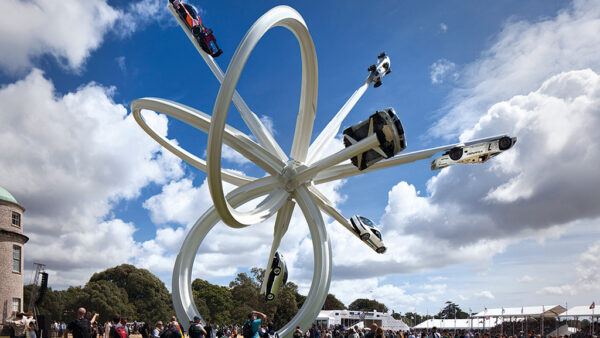
Gold winner: Ayr Academy (Image: Graeme Duncan)
GOLD: Andrew McTavish – Kier

Project: Ayr Academy. Construction of single-campus school for 1,000 pupils, with a 4G pitch, three gym halls, outdoor grass pitch, multi-use hall and a dance studio. Completed in 79 weeks.
Contract: Design, build, finance, maintain
Value: Tender £24m, final contract £24m
Andrew McTavish’s programme mastery was the key to success on this three-storey academy build. His value-engineering list included retention on site of all excess material strip and topsoil, with 15,000 cu m used under the grass pitch.
When it emerged that ground conditions wouldn’t support the staff car park under construction, importing hardcore would have pushed the project into the red. McTavish instead picked a geotextile design that reduced the cost of the works by 70%.
McTavish also solved the difficulty posed by having to install the steel frame for the gym block before completing the post-tensioned concrete frame of the main teaching block to which it connected. On a site with restricted access, he brought in two cranes, so he could erect the steel frame without waiting on the concrete frame.
His close monitoring of the site, regular communication with the professional team and supply chain, and careful planning set high standards early on. By effectively completing construction a fortnight before the handover date, McTavish was able to put all his focus on the finishing trades to deliver a quality building.
SILVER: Dave Nott ICIOB – Wates

Silver winner: Sammy Ofer Centre, London

Project: Sammy Ofer Centre, London. Conversion of two grade II-listed buildings to an academic facility, with six lecture theatres and a new-build glazed link structure. Completed in 142 weeks.
Contract: JCT 2011, without quantities
Value: Tender £54m, final contract £75m
On this refurbishment of two listed structures for use as an academic facility, Dave Nott had to twist and weave a mass of very different project strands together without tying himself up in knots. The challenges included the need to thread 21st-century M&E systems – plus audiovisual and IT equipment – into a century-old building where no structural plans existed.
The two buildings had been constructed very differently, and their potential to move at different rates made the construction of steel beams in the link building particularly problematic.
Other finalists
Alan Bell, BAM Construct UK – Coventry University Science and Health Building
Nigel Harris MCIOB, Willmott Dixon – Faculty of Engineering, Queens Building New Wing, University of Bristol
Lianne Lawson, Interserve – Piazza, University of York
Jamie O’Shea, Bouygues – Lady Margaret Hall, Oxford
Ian Rainbow MCIOB, BAM Construct UK – Sarah Swift Building, University of Lincoln
The borders of the site, in the centre of London, included a busy road and Nott had to manage a team of 72 subcontractors and 300 site workers at peak.
The initial quotes for the glazed curtain wall came back well over budget, but Nott found a subcontractor that delivered a 20% saving on the package, despite the complex design.
In total he delivered over £3m of value engineering by reconsidering cladding, services and finishes as well as the structural items.
He also treated the steel-framed building’s “Regent Street disease”, where the rusting of the metal over the years had destabilised the Portland stone cladding. With the local conservation authority reluctant for the facade to be removed to expose the steel frame for treatment, Nott turned to cathodic protection of the steel. He researched and sourced the specialists to install it with a 100-year guarantee.
Category sponsored by











